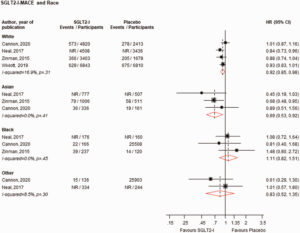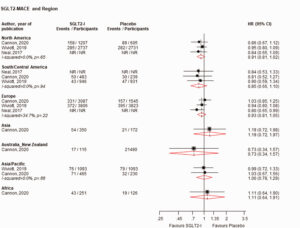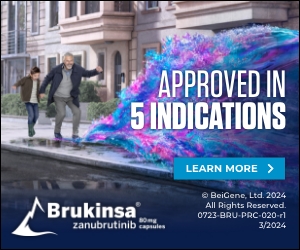
[Click image to enlarge]
Risk for MACE comparing SGLT2-I with placebo by race.CI: confidence interval (bars); HR: hazard ratio; MACE: major adverse cardiovascular events; NR: not reported; SGLT2-I: sodium–glucose co-transporter 2 inhibitor.
Source: Grandhi N, Liu L, Thomas T, Kumar A, Gao F, Sanfilippo KM, Colditz G, Chang SH. Racial Differences in the association of Glucagon-like Peptide 1 Agonist Use and the Progression of Monoclonal Gammopathy of Undetermined Significance to Multiple Myeloma in U.S. Veterans with Diabetes Mellitus. Abstract 4772. ASH 2023. Dec. 11, 2023
GLP-1 agonist use also has been linked to a 65% reduction in the risk of progression from monoclonal gammopathy of undetermined significant (MGUS) to multiple myeloma in U.S. veterans with diabetes mellitus (DM). A meta-analysis of 14 studies, however, found significant racial variations in the benefit of GLP-1 receptor agonists, with white and Asian population seeing consistent cardiorenal benefits while Black populations consistently demonstrated no benefit.1
The meta-analysis was unable to answer whether the lack of benefit seen in Black patients was a result of underrepresentation of that population in studies without the statistical power to tease out the relationship or true variation in pharmacokinetics or pharmacodynamics.
As the nation’s largest healthcare system, the VA has an unusual ability to address such questions, as it has broad racial representation, and its structure largely eliminates issues around access and availability. In addition, it has more patients with diabetes that any other healthcare provider in the U.S. Consequently, researchers at the St. Louis VAMC and colleagues turned to the VHA database to assess racial differences in the association between GLP-1 agonist use and progression of MGUS to multiple myeloma in veterans with diabetes.2
The research team identified veterans diagnosed with MGUS and diabetes in the VHA database between Oct. 1, 1999, and Dec. 31, 2021. After eliminating those diagnosed with diabetes after their MGUS diagnosis and those who progressed within one year of MGUS diagnosis or two years of diabetes diagnosis, the study included 9,294 white veterans and 4,981 Black veterans. Of those, 909 of the white patients and 403 of the Black patients were prescribed GLP-1 agonists.
Patient matching (1:2 for patients with and without GLP-1 agonist use) left an analytic cohort of 2,718 white veterans and 1,191 Black veterans, with one-third of each group using GLP-1 agonists.

[Click image to enlarge]
Risk for MACE comparing SGLT2-I with placebo by region.CI: confidence interval (bars); HR: hazard ratio; MACE: major adverse cardiovascular events; NR: not reported; SGLT2-I: sodium–glucose co-transporter 2 inhibitor.
Source: Grandhi N, Liu L, Thomas T, Kumar A, Gao F, Sanfilippo KM, Colditz G, Chang SH. Racial Differences in the association of Glucagon-like Peptide 1 Agonist Use and the Progression of Monoclonal Gammopathy of Undetermined Significance to Multiple Myeloma in U.S. Veterans with Diabetes Mellitus. Abstract 4772. ASH 2023. Dec. 11, 2023
They concluded that, “for patients with MGUS and DM, GLP-1 agonist use is associated with a 75% reduction in progression risk in white patients and no significant reduction in Black patients. This highlights a racial disparity in the potential role of GLP-1 agonist for chemoprevention in the management of MGUS.”
1Kunutsor SK, Khunti K, Seidu S. Racial, ethnic and regional differences in the effect of sodium-glucose co-transporter 2 inhibitors and glucagon-like peptide 1 receptor agonists on cardiovascular and renal outcomes: a systematic review and meta-analysis of cardiovascular outcome trials. J R Soc Med. 2023 Sep 21:1410768231198442.
2Grandhi N, Liu L, Thomas T, Kumar A, Gao F, Sanfilippo KM, Colditz G, Chang SH. Racial Differences in the association of Glucagon-like Peptide 1 Agonist Use and the Progression of Monoclonal Gammopathy of Undetermined Significance to Multiple Myeloma in U.S. Veterans with Diabetes Mellitus. Abstract 4772. ASH 2023. Dec. 11, 2023.

